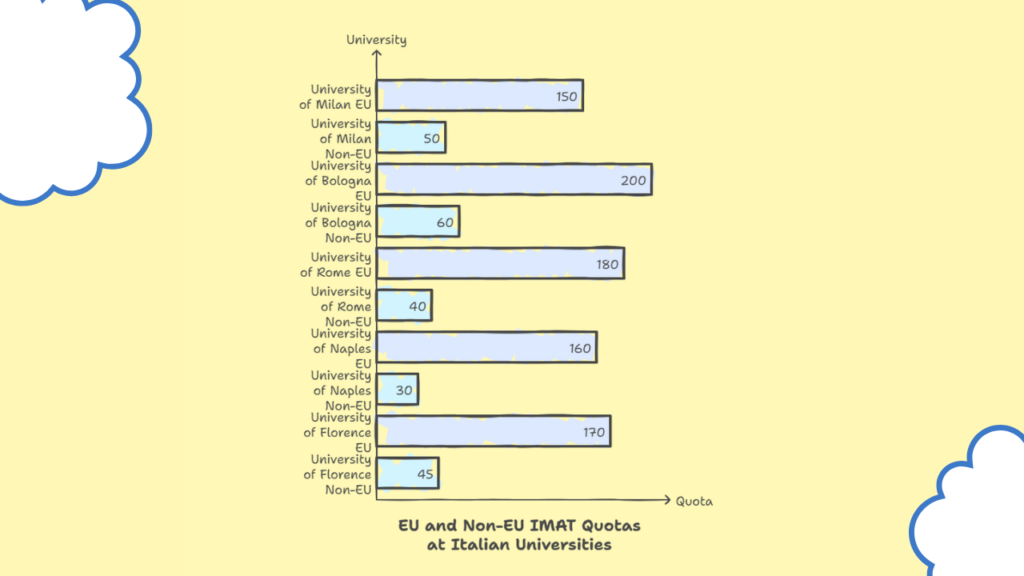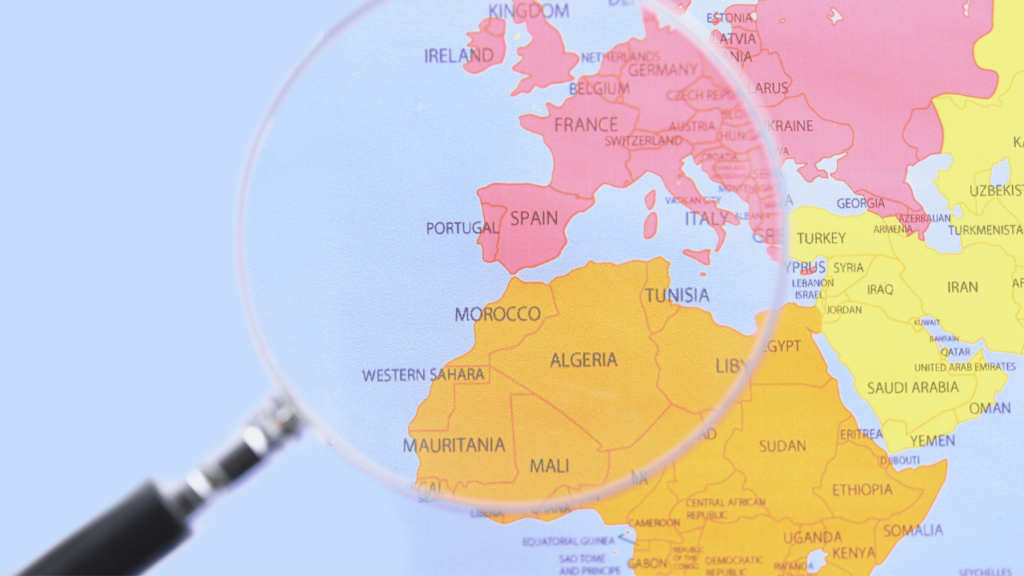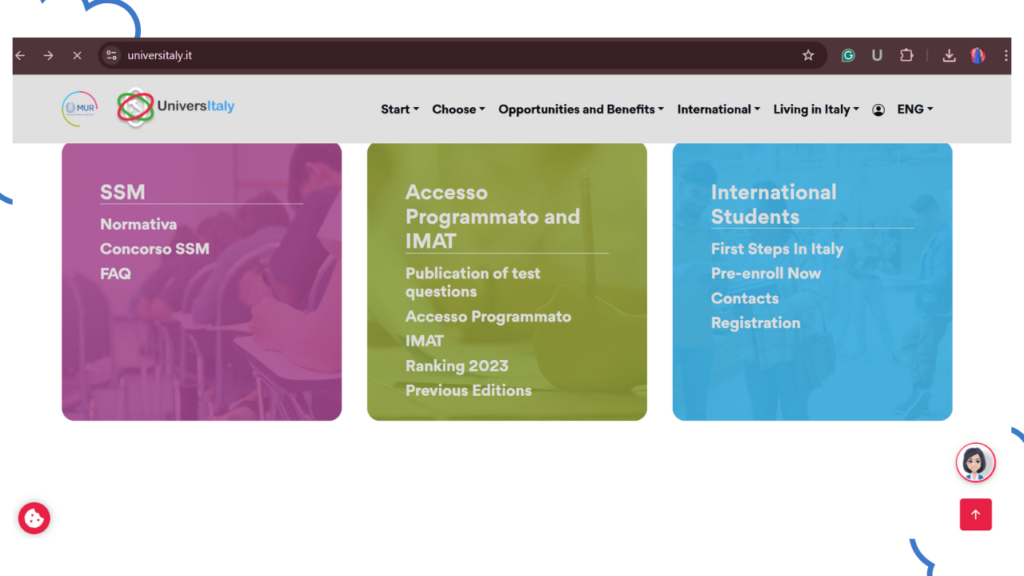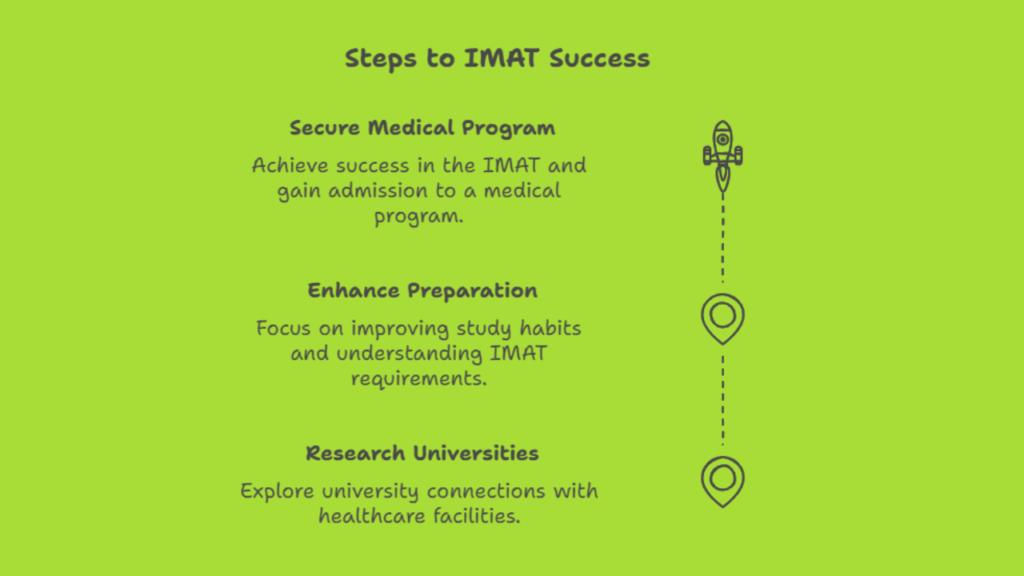
Table of Contents
Are you dreaming of studying medicine in Italy? If so, you’ve likely heard about the IMAT exam. IMAT stands for International Medical Admission Test. It’s a special test for students who want to study medicine or surgery in English at public universities in Italy.
But there’s something significant you need to know before you apply — and that is quotas. Quotas are like seats saved for certain groups of students. When applying for the IMAT, students are split into two groups: EU students and non-EU students. The difference between EU and non-EU IMAT quotas becomes super important.
Knowing which group you belong to can change your whole admission journey. Why? Because the number of seats, the level of competition, and the rules are different for EU and non-EU students.
In this blog, we will make it very easy for you to understand the difference between EU and non-EU IMAT quotas. You’ll learn what each term means, how many seats are available, and how it affects your chances of getting into a medical school in Italy.
Let’s get started!
What Are IMAT Quotas?

Before we go deeper into the difference between EU and non-EU IMAT quotas, let’s first understand what a quota is.
A quota means a fixed number of seats or spots available at a medical university. These seats are for students who pass the IMAT exam and want to study medicine or surgery in English in Italy. But not all students fight for the same seats. The seats are divided into two parts — EU quota and Non-EU quota.
Why Are Students Divided Into EU and Non-EU?
Students are grouped based on their nationality or where they live. If you are from a country that is part of the European Union (EU), then you fall under the EU quota. If you are from any other country outside the EU, then you are in the Non-EU quota.
The Italian government does this to make the admission process fair for both Italian/European students and international students. It also helps manage the number of foreign students coming to study in Italy each year.
This division is a big reason why understanding the difference between EU and non-EU IMAT quotas is so important. It can tell you how many seats are available for you and how hard the competition might be.
Who Is an EU Student?

Now that we know there are two groups for IMAT quotas, let’s talk about EU students first.
What Makes Someone an EU Applicant?
You are considered an EU student if you are a citizen of a European Union (EU) country. You can also be treated as an EU applicant if you live in the EU and have certain legal rights there. This means that even if you are not born in an EU country, you may still be considered EU if you live there legally and meet some special rules.
Example Countries That Are Part of the EU:
- Italy
- France
- Germany
- Spain
- Poland
- Netherlands
- Sweden
- Austria
- Greece
- Romania
There are 27 countries in the EU. If your country is one of them, then you apply under the EU quota.
Rights and Rules for EU Students
EU students have more rights when applying to Italian universities. They are treated the same as Italian students in most ways. This means:
- They don’t need a student visa.
- They can apply to more universities.
- They usually face less strict rules during the admission process.
- They may get more seats available in their quota.
Understanding who counts as an EU student helps you know where you fit in the difference between EU and Non-EU IMAT quotas. It’s the first step in making your IMAT plan smart and strong.
Who Is a Non-EU Student?

Now let’s talk about the other group — the Non-EU students. If your country is not part of the European Union, you will apply under the Non-EU quota.
What Is a Non-EU Student?
A non-EU student is someone who is a citizen of a country outside the European Union. For example, if you are from:
- Pakistan
- India
- Nigeria
- Brazil
- Egypt
- United States
- China
…you are considered a Non-EU applicant for IMAT. Even if you live in Europe, you will still be in the Non-EU quota unless you have EU citizenship or special legal status.
Rules and Documents for Non-EU Students
Non-EU students have different rules to follow compared to EU students. They must:
- Apply early through the Italian embassy or consulate in their country
- Submit a document called Declaration of Value (DoV)
- Show proof of a high school diploma
- Provide passport and visa documents
- Get a student visa after being accepted
- Sometimes take a language test (depending on the university)
These steps can take time, so Non-EU students must start early and be very careful with deadlines.
Differences in the Application Process
Unlike EU students, non-EU students can only apply to one university each year for the IMAT. This makes the process more challenging. If they don’t get a seat at that one university, they don’t have another chance until next year.
This shows how the difference between EU and non-EU IMAT quotas affects not just your chances, but also your entire application process. Non-EU students have to be more focused and better prepared.
Main Differences Between EU and Non-EU IMAT Quotas

Now that we know who is an EU student and who is a Non-EU student, let’s look at the main differences between EU and Non-EU IMAT quotas. These differences are super important and can affect your chances of getting into a medical school in Italy.
1. Number of Seats Available
One of the biggest differences between EU and non-EU IMAT quotas is the number of seats. Most Italian medical universities have more seats for EU students and fewer seats for non-EU students.
For example:
- A university might have 50 seats for EU students but only 15 for non-EU students.
This makes it harder for non-EU students because fewer spots are available.
2. Competition Level
Since there are fewer seats for non-EU students, the competition is much tougher. Many smart students from around the world apply for those limited seats, so the scores usually have to be higher to get in.
For EU students, the competition is also tough, but they may have more options since they can apply to multiple universities, not just one.
3. Tuition Fee Differences
The tuition fees in most Italian universities are similar for both EU and non-EU students. However, EU students often have easier access to scholarships and lower fees based on family income.
Non-EU students might pay the same amount, but it’s sometimes harder for them to apply for financial help.
4. Application Requirements
The application process is also different:
- EU students apply directly through the university website or the national system.
- Non-EU students apply for the IMAT through the Italian embassy in their home country.
- Non-EU students must also go through pre-enrollment, visa applications, and may need extra documents like a Declaration of Value (DoV).
As you can see, the difference between EU and non-EU IMAT quotas is not just about seat numbers. It includes how you apply, the chances of getting in, and even how much you might pay. That’s why it’s so important to know your category and plan carefully.
Why the Difference Between EU and Non-EU IMAT Quotas Matters

You might be wondering, “Why is this such a big deal?” Well, the difference between EU and non-EU IMAT quotas can change your whole journey when applying to study medicine in Italy.
How It Impacts Your Chances of Getting Accepted
Imagine two students who both score well on the IMAT. One is from Germany (EU) and one is from India (Non-EU). Even if they both score the same, the non-EU student might not get a seat because there are fewer seats in that quota and more competition.
So, the number of seats, your passport, and your legal status all affect how easy or hard it is to get into an Italian medical university.
Why Knowing This Helps You Plan Better
When you understand the difference between EU and non-EU IMAT quotas, you can make smart choices. Here’s how:
- You can check how many seats are available for your quota.
- You’ll know what documents and steps you need.
- You can study harder if you’re in a more competitive group.
- You’ll avoid mistakes by applying the right way.
Knowing your quota early helps you save time, avoid stress, and gives you a better shot at success!
How to Check the Seats for EU and Non-EU Quotas

If you’re getting ready for the IMAT, it’s super important to check how many seats are available for your group. That’s how you understand the difference between EU and Non-EU IMAT quotas in real life — with real numbers!
Where to Find Quota Information
Each year, the Italian Ministry of Education (called MIUR) shares the number of seats for all public medical universities. This list is published in the official IMAT call or announcement.
You can find the quota info on:
- The official university websites
- The Universitaly website (www.universitaly.it)
- The MIUR website (if you know some Italian)
- IMAT study websites or guides like The IMAT Master
Just make sure you’re looking at the latest IMAT call for the correct year!
Example from Past Years
Let’s look at an example from a past IMAT year:
University of Milan (2023 example):
- EU Seats: 50
- Non-EU Seats: 15
University of Pavia (2023 example):
- EU Seats: 103
- Non-EU Seats: 40
This shows the real difference between EU and non-EU IMAT quotas. Most universities give more seats to EU students than non-EU students.
By checking these numbers early, you’ll know where you have the best chances and which universities fit your goals.
Tips for Non-EU Students to Improve Their Chances

If you’re a non-EU student, don’t worry! Even though there are fewer seats, there are smart ways to improve your chances of getting in. The difference between EU and non-EU IMAT quotas may seem scary, but with the right plan, you can still win a seat.
1. Study Smart and Start Early
Since the competition is tough, you need to score high on the IMAT exam. Start your preparation early and make a good study schedule. Focus on all parts of the test, like:
- Biology
- Chemistry
- Physics and Math
- Logical Reasoning
- General Knowledge
Practice with past papers and time yourself so you get used to the exam style.
2. Apply Early and Follow All Steps
Non-EU students must go through pre-enrollment at the Italian embassy in their country. This can take time, so it’s best to:
- Start early
- Collect all your documents
- Check embassy deadlines
- Follow the visa process carefully
Missing a step could delay or cancel your chance, even if you pass the exam!
3. Pick the Right University
Not all universities are the same. Some give more seats to non-EU students than others. Look at past years and choose a university with more Non-EU seats and slightly lower cut-off scores. This can improve your chances.
You should also think about:
- The city (Do you like big or small cities?)
- Cost of living
- Language help (some places offer Italian lessons)
Making the right choices can help you succeed, even with the difference between EU and non-EU IMAT quotas.
Can a Non-EU Student Become an EU Student?

Many non-EU students wonder, “Can I become an EU student and apply under the EU quota?” Let’s examine this question more closely.
Is It Possible?
Yes, it is possible, but it’s not easy. To apply under the EU quota, you need to meet certain rules, such as having EU citizenship or meeting specific residency requirements.
How Citizenship or Residency Affects the Quota
If you are born in a non-EU country, but later you become a citizen of an EU country (for example, by naturalization or family ties), you can apply as an EU student. Some countries allow you to get EU citizenship after living there for several years.
Also, if you live in an EU country and meet certain rules, you may be able to apply under the EU quota instead of the Non-EU quota. For example, you might need to show you’ve lived in an EU country for at least two years.
Rules for Change
Changing from a non-EU student to an EU student depends on:
- Citizenship: Becoming an EU citizen through birth, marriage, or naturalization.
- Residency: Meeting the minimum residency requirements in an EU country.
It’s important to check the specific rules for the country you are applying to because they may vary. So, while it’s possible, it’s not something that happens quickly.
Conclusion: Know Your Quota and Plan Smart
Let’s quickly recap what we’ve learned about the difference between EU and non-EU IMAT quotas:
- IMAT quotas refer to the number of spots available for both EU and non-EU students.
- EU students have more seats and fewer application steps than non-EU students.
- Non-EU students face more competition and need to follow extra steps like applying through the embassy and getting a visa.
- There are big differences in the number of seats, competition, tuition fees, and application processes for EU and non-EU students.
Now that you know how EU and Non-EU quotas work, you can plan your journey better. Whether you’re an EU student or a non-EU student, the most important thing is to stay focused on your goal. Keep working hard, study smart, and use all the resources available to you.
No matter what quota you fall under, your dream of studying medicine in Italy is possible with the right preparation and attitude!
FAQs
- What is the main difference between EU and non-EU IMAT quotas?
The main difference between EU and Non-EU IMAT quotas is the number of seats available. EU students usually have more seats than Non-EU students, which makes it a bit easier for them to get in. Non-EU students face more competition due to fewer spots available. - Do non-EU students have a lower chance of getting accepted?
Yes, non-EU students generally have fewer chances of getting in because there are fewer seats for them. The competition is higher for non-EU students, so they need to score higher on the IMAT exam to secure a spot. - Can I apply under the EU quota if I live in Europe but don’t have an EU passport?
It depends! If you live in an EU country and meet the residency requirements, you might be able to apply under the EU quota. Usually, you must have lived in an EU country for at least two years before applying. - Do tuition fees differ for EU and non-EU students?
In most cases, tuition fees are similar for both EU and Non-EU students. However, EU students may have better access to financial aid, like scholarships and reduced fees, based on family income, while Non-EU students might face higher costs and fewer options for financial support. - Where can I find quota information for IMAT universities?
You can find quota information on official university websites, the Universitaly website, and the MIUR website. It’s important to check the official IMAT call for the current year to see the exact number of seats available. - Can I switch from Non-EU to EU status later?
Yes, it’s possible if you become an EU citizen or meet residency requirements. For example, if you live in an EU country for several years, you might be able to apply under the EU quota. However, the process takes time and depends on specific rules for each country.


